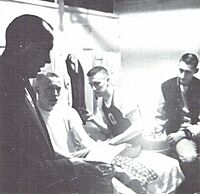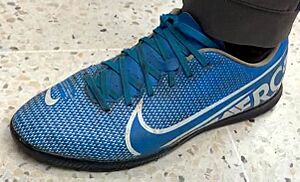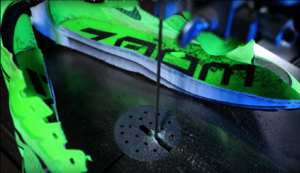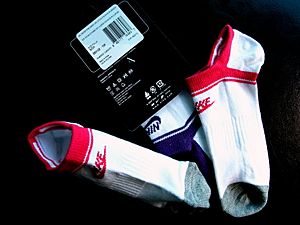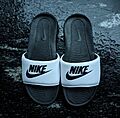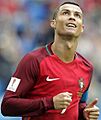Nike, Inc. facts for kids

The famous Swoosh logo, used since 1971.
|
|
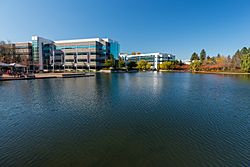
Headquarters near Beaverton, Oregon, U.S.
|
|
|
Formerly
|
Blue Ribbon Sports, Inc. (1964–1971) |
|---|---|
| Public | |
| Traded as | |
| ISIN | ISIN: [https://isin.toolforge.org/?language=en&isin=US6541061031 US6541061031] |
| Industry |
|
| Founded | January 25, 1964 |
| Founders | |
| Headquarters | Nike World Headquarters Unincorporated Washington County near Beaverton, Oregon, U.S. |
|
Area served
|
Worldwide |
|
Key people
|
|
| Products |
|
| Revenue | |
|
Operating income
|
|
| Total assets | |
| Total equity | |
|
Number of employees
|
79,400 (2024) |
| Subsidiaries | Converse |
Nike, Inc. is a famous American company that makes athletic shoes, clothes, and sports equipment. You probably know it by its famous Swoosh logo and "Just Do It" slogan. Headquartered near Beaverton, Oregon, Nike is the world's biggest seller of athletic shoes and clothing.
The company started on January 25, 1964, but it wasn't called Nike back then. It was named "Blue Ribbon Sports" by its founders, Bill Bowerman and Phil Knight. They officially changed the name to Nike, Inc. on May 30, 1971. The name comes from Nike, the Greek goddess of victory, which is a perfect fit for a sports brand!
Nike sells products under many brand names, including Nike Pro, Air Max, and Air Jordan. It also owns the popular shoe company Converse. Nike is known for sponsoring famous athletes and sports teams all over the world, making it one of the most recognized brands on the planet.
The Story of Nike
Nike began as Blue Ribbon Sports (BRS), founded by Phil Knight, a track athlete at the University of Oregon, and his coach, Bill Bowerman. At first, they didn't make their own shoes. They sold running shoes from a Japanese company called Onitsuka Tiger. Knight would often sell the shoes right out of his car at track meets.
In their first year, BRS sold 1,300 pairs of shoes and made $8,000. By 1966, they opened their first store in Santa Monica, California.
The Waffle Sole
A huge breakthrough came in 1971. Bill Bowerman was trying to create a new shoe sole that could grip a track without using spikes. While having breakfast with his wife, he got an idea from their waffle iron! He poured rubber into it and created a new, lightweight sole with a waffle-like pattern.
This invention led to the "Moon Shoe" in 1972, and later the "Waffle Trainer" in 1974. These shoes were a massive hit and helped the company grow incredibly fast.
Becoming Nike
By 1971, BRS was ready to create its own brand. They needed a name and a logo. An employee named Jeff Johnson came up with the name "Nike." A graphic design student named Carolyn Davidson created the logo, which we now know as the Swoosh. She was paid just $35 for her work at the time! The Swoosh was first used on a shoe on June 18, 1971.
By 1980, Nike had captured half of the U.S. athletic shoe market. That same year, the company went public, meaning people could buy shares of Nike stock.
"Just Do It"
In 1988, Nike launched one of the most famous advertising slogans of all time: "Just Do It". The slogan was created by Dan Wieden from the advertising agency Wieden+Kennedy. It appeared in a commercial featuring 80-year-old runner Walt Stack and quickly became a global sensation, inspiring millions of people.
What Does Nike Own?
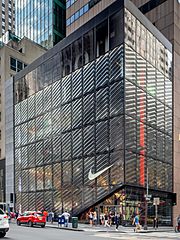
Over the years, Nike has bought several other companies. These are called acquisitions.
- In 1988, it bought a fancy shoe company called Cole Haan.
- In 1994, it bought hockey equipment maker Bauer Hockey.
- In 2002, it acquired the surf brand Hurley International.
- In 2003, Nike bought Converse, the maker of the classic Chuck Taylor All-Star sneakers, for $309 million.
Later, Nike decided to focus more on its main brand. It sold Bauer, Cole Haan, and other companies it had bought. Today, Converse is the main company that Nike still owns.
Nike's Famous Products
Nike makes a huge variety of sports gear, from shoes to clothes.
Shoes for Every Sport
Nike started with running shoes, but now they make footwear for almost every sport imaginable. This includes basketball, soccer, skateboarding, and tennis.
Some of their most famous shoe lines include:
- Nike Air Max: First released in 1987, these shoes are known for the visible air cushion in the heel.
- Air Jordan: Created for basketball legend Michael Jordan, this brand is now a fashion icon.
- Nike SB: A line of shoes designed specifically for skateboarding.
The Vaporfly Shoe
In 2017, Nike released the Vaporfly running shoe. This shoe was a game-changer for long-distance runners. Studies showed it could help runners improve their marathon times.
The shoe uses a special lightweight foam called ZoomX and has a carbon fiber plate inside the sole. This combination gives runners extra spring in their step. Nike even marketed its newest version as "the fastest shoe we’ve ever made."
Fashion on the Street
Nike isn't just for sports. The brand became a symbol of style in urban fashion and hip-hop fashion. In the 1980s, Nike tracksuits, baseball caps, and especially Air Jordan and Air Force 1 sneakers became very popular.
Today, people mix Nike gear like leggings, sweatpants, and sneakers with everyday clothes. Even Nike Elite basketball socks, once just for the court, became a fashion statement.
In 2015, Nike created a real-life version of the self-lacing shoes from the movie Back to the Future Part II. These shoes, called the Nike Mag, were sold at auction to raise money for charity.
Helping the Planet
Nike is working to be more environmentally friendly.
Recycling Old Shoes
Since 1993, Nike's Reuse-A-Shoe program has collected old athletic shoes of any brand. The shoes are ground up and recycled into a material called Nike Grind. This material is then used to make new sports surfaces like basketball courts, running tracks, and playgrounds.
In 2008, Nike even made a basketball shoe called the "Trash Talk Shoe." It was built from leftover leather and rubber from their factories.
Reducing Its Footprint
Nike is also trying to reduce pollution. The company is working to use less water in its factories and has set goals to lower its carbon footprint. A carbon footprint is the total amount of greenhouse gases produced by a person, organization, or product.
In 2019, Nike started a program called "Move to Zero." The goal is to have zero carbon emissions and zero waste. They are using more recycled and organic materials in their clothes to help achieve this.
Marketing and Sponsorships
A huge part of Nike's success is its marketing. The company sponsors famous athletes and teams to promote its products.
Partnering with Stars
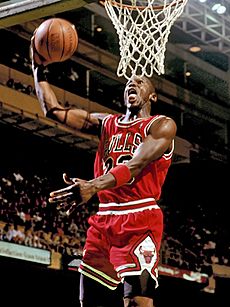
Nike's first athlete endorser was tennis player Ilie Năstase. But the partnership that changed everything was with basketball player Michael Jordan in 1984. The Air Jordan line of shoes became a cultural phenomenon and made Nike a global powerhouse.
Nike has sponsored many other sports legends, including:
- Soccer: Cristiano Ronaldo, Kylian Mbappé, and Neymar.
- Tennis: Roger Federer, Rafael Nadal, and Serena Williams.
- Golf: Tiger Woods and Rory McIlroy.
- Basketball: LeBron James, Kevin Durant, and Caitlin Clark.
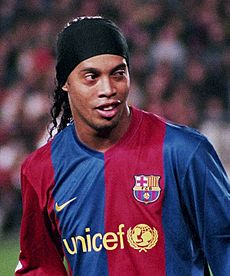
Nike also provides uniforms for major sports leagues and teams. In 2015, Nike became the official uniform supplier for the NBA. It also makes kits for top soccer clubs like FC Barcelona and Liverpool F.C., and national teams like Brazil and France.
Images for kids
See also
 In Spanish: Nike para niños
In Spanish: Nike para niños
- Bruce Brenn
- Dick Donahue
- Nike timeline
- Breaking2 – A project by Nike to break the 2 hour marathon barrier.
- List of companies based in Oregon


